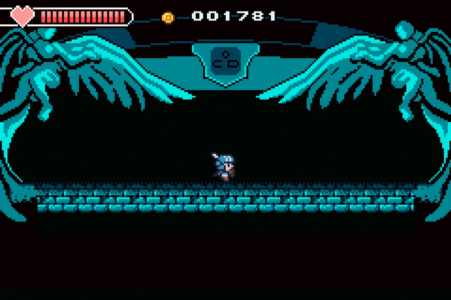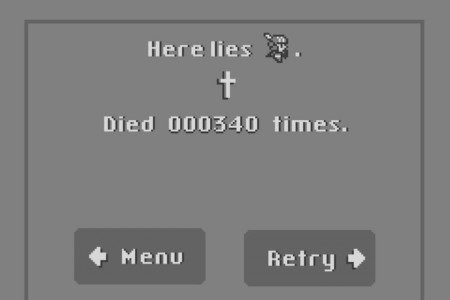Nicalis have made a name for themselves in recent years with their creation and handling of retro-styled titles. Matt Kap, one of the artists in the envoy of Nicalis, has just finished developing and releasing an independently developed title called Castle in the Darkness. As a title that often references the works of Metroid/Castlevania, is Castle in the Darkness one of the next great classics, or is it simply paying tribute?
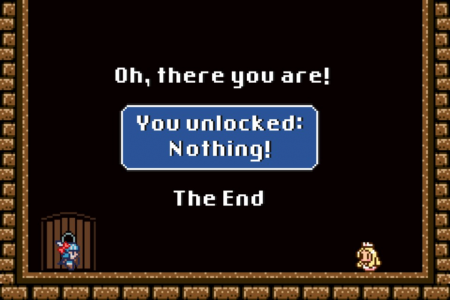
Castle in the Darkness opens as so many games of the past do: a princess is trapped away in a castle, an unnamed knight ventures off to save her, so on and so forth. It’s a tale retold through centuries each told in different form and Castle in the Darkness is no different.
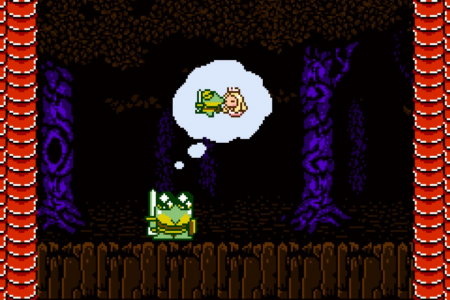
The cast of Castle in the Darkness is a relatively small one. From the unnamed knight to the princess with a few tricks up her sleeve to her missing father, the king, and even to a frog knight that pops his head in from time to time, there’s not much in terms of interaction with the world beyond the occasional dialogue preceeding a boss fight or an NPC in need of some assistance, aka optional side quests. Much of the supporting cast you’ll interact with once throughout the story and then you’ll never see them again. While this may sound like a negative aspect, I was glad to not have to repeatedly come back to the same NPC over and over for various quests and tasks.
Much like the retro pixel art-style that Matt Kap has created for Castle in the Darkness, there are more than a few subtle nods to gaming culture of the past thirty years. Gags and easter eggs are strewn across the world in all kinds of ways, from little pieces of dialogue to some of the more obvious objects hanging out in the background. If you’re fairly well versed in the gaming classics, you’re bound to crack a smile at some of the references hidden throughout Castle in the Darkness.
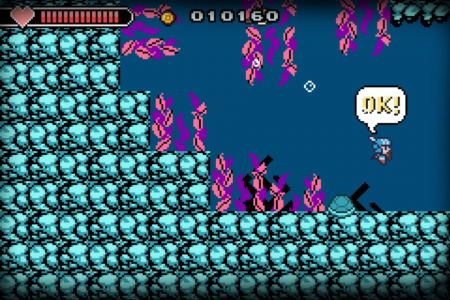 To say Castle in the Darkness is like a Metroidvania game would be an understatement. Exploration is a huge aspect of the game and even the most minor of upgrades could easily open new paths. Every time that I acquired a new ability such as a double jump or a secret key, I routinely found myself backtracking through the world trying to figure out where these could best be put to use. Even from behind something mundane such as a breakable wall, there would sometimes be a path that would lead to an entirely new dungeon or area to explore.
To say Castle in the Darkness is like a Metroidvania game would be an understatement. Exploration is a huge aspect of the game and even the most minor of upgrades could easily open new paths. Every time that I acquired a new ability such as a double jump or a secret key, I routinely found myself backtracking through the world trying to figure out where these could best be put to use. Even from behind something mundane such as a breakable wall, there would sometimes be a path that would lead to an entirely new dungeon or area to explore.
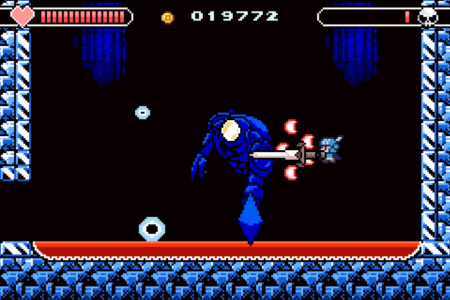 If you’ve ever played the Wonder Boy or Ys series of games from the early-’90s, Castle in the Darkness takes great inspiration from them. Rather than leveling up the knight through experience and repeated battles, new upgrades come by way of additional hearts hidden throughout the levels or from defeating each boss. A healthy number of new weapons, armor, and spells complement his fighting ability and even certain combinations could lead to new effects. Wearing the green tunic and the guard sword, for example, gives the knight a beam that shoots from the tip of his blade, ala The Legend of Zelda. More than just swords, there are also bows, boomerangs, axes, and spears to wield, each playing differently during boss fights.
If you’ve ever played the Wonder Boy or Ys series of games from the early-’90s, Castle in the Darkness takes great inspiration from them. Rather than leveling up the knight through experience and repeated battles, new upgrades come by way of additional hearts hidden throughout the levels or from defeating each boss. A healthy number of new weapons, armor, and spells complement his fighting ability and even certain combinations could lead to new effects. Wearing the green tunic and the guard sword, for example, gives the knight a beam that shoots from the tip of his blade, ala The Legend of Zelda. More than just swords, there are also bows, boomerangs, axes, and spears to wield, each playing differently during boss fights.
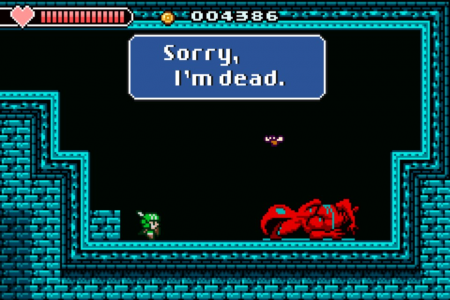 Spells are another asset at your disposal in Castle in the Darkness. Thankfully, any sort of MP system is gone from the game. Instead, it’s as simple as holding down the attack button to charge up power. There are some enemies that can only be damaged by magic as opposed to physical weapons, or vice versa, so it’s important to know when and where to use these spells. A personal favorite of mine, while towards the end of the game and acquired by defeating an incredibly powerful optional boss, doubled the number of attacks my knight could do per swing in addition to giving him a strong laser beam after charging long enough.
Spells are another asset at your disposal in Castle in the Darkness. Thankfully, any sort of MP system is gone from the game. Instead, it’s as simple as holding down the attack button to charge up power. There are some enemies that can only be damaged by magic as opposed to physical weapons, or vice versa, so it’s important to know when and where to use these spells. A personal favorite of mine, while towards the end of the game and acquired by defeating an incredibly powerful optional boss, doubled the number of attacks my knight could do per swing in addition to giving him a strong laser beam after charging long enough.
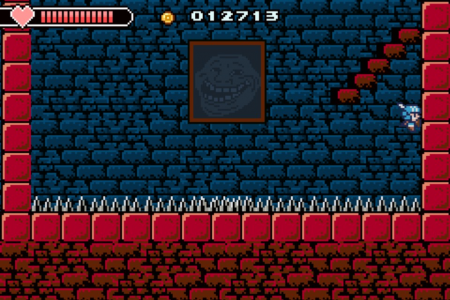 If all you had to deal with in Castle in the Darkness was taking damage from enemies or the occasional trap, the game would be a pretty average difficulty game (with some really challenging boss fights!). Instead, Matt Kap decided that wasn’t enough and added in an obscenely high number of spikes to navigate around. Just like the golden days of Megaman, touching these spikes leads to instant death. It’s not just stationary spikes on the ground, either. Ceiling spikes can drop down at a moment’s notice and easily lead to a number of deaths I could only gaze at in bewilderment.
If all you had to deal with in Castle in the Darkness was taking damage from enemies or the occasional trap, the game would be a pretty average difficulty game (with some really challenging boss fights!). Instead, Matt Kap decided that wasn’t enough and added in an obscenely high number of spikes to navigate around. Just like the golden days of Megaman, touching these spikes leads to instant death. It’s not just stationary spikes on the ground, either. Ceiling spikes can drop down at a moment’s notice and easily lead to a number of deaths I could only gaze at in bewilderment.
Castle in the Darkness certainly has a huge emphasis on trial-and-error as you navigate through the world. Checkpoints are spaced far enough away from each other that there’s a feeling of accomplish after getting through a section. One minor gripe that popped up frequently through my playthrough was that gathering an item or defeating a boss sometimes just wasn’t enough. Returning back to a save point is required to keep your loot, and sometimes navigating through some of the trickier stretches of the game in reverse could be more daunting than getting the loot in the first place. If you’re not patient enough for repetition and learning the finer arts of getting good, this may not be the one for you.
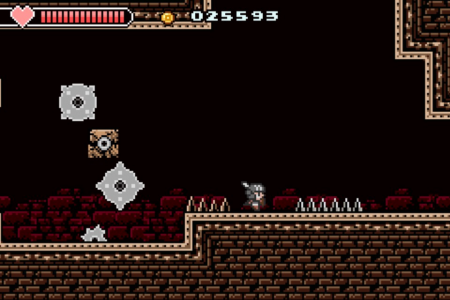 Castle in the Darkness is not without its rough spots, however. Hit stun is one of the more bothersome parts to combat. After getting hit, there’s no period of invulnerability or chance to get your bearings back. During boss fights where just a couple of hits can mean certain death, getting juggled around by an enemy’s fireball barrage can mean a frustrating end to a fight that might have otherwise been going well. There are a few other weird anomalies or bugs that pop up throughout normal play, such as objects in the environment sometimes duplicating themselves when you leave a room and come back. There’s nothing quite like making your way through a dungeon, getting the loot at the end, then finding that you can’t make your way back because of an extra buzz saw that shouldn’t be there.
Castle in the Darkness is not without its rough spots, however. Hit stun is one of the more bothersome parts to combat. After getting hit, there’s no period of invulnerability or chance to get your bearings back. During boss fights where just a couple of hits can mean certain death, getting juggled around by an enemy’s fireball barrage can mean a frustrating end to a fight that might have otherwise been going well. There are a few other weird anomalies or bugs that pop up throughout normal play, such as objects in the environment sometimes duplicating themselves when you leave a room and come back. There’s nothing quite like making your way through a dungeon, getting the loot at the end, then finding that you can’t make your way back because of an extra buzz saw that shouldn’t be there.
Overall, Castle in the Darkness hits that perfect sweet spot of exploring the world with new abilities coupled with secrets all over the world. It’s one of the finest Metroidvania-styled games I’ve played in years and the $6 price point should make it an instant buy for fans of the genre. While Castle in the Darkness can be punishingly difficult, especially with how many ways there are to instantly die in the game, the sense of accomplishment after every boss fight can be enough of a reward to persevere and keep going. For the nine hours I spent seeing Castle in the Darkness through until the ending credits, I loved every minute of it, even when I felt like snapping my controller in two.
[Editor’s Note: Castle in the Darkness was reviewed on Steam. Review code was provided to us by the publisher.]


